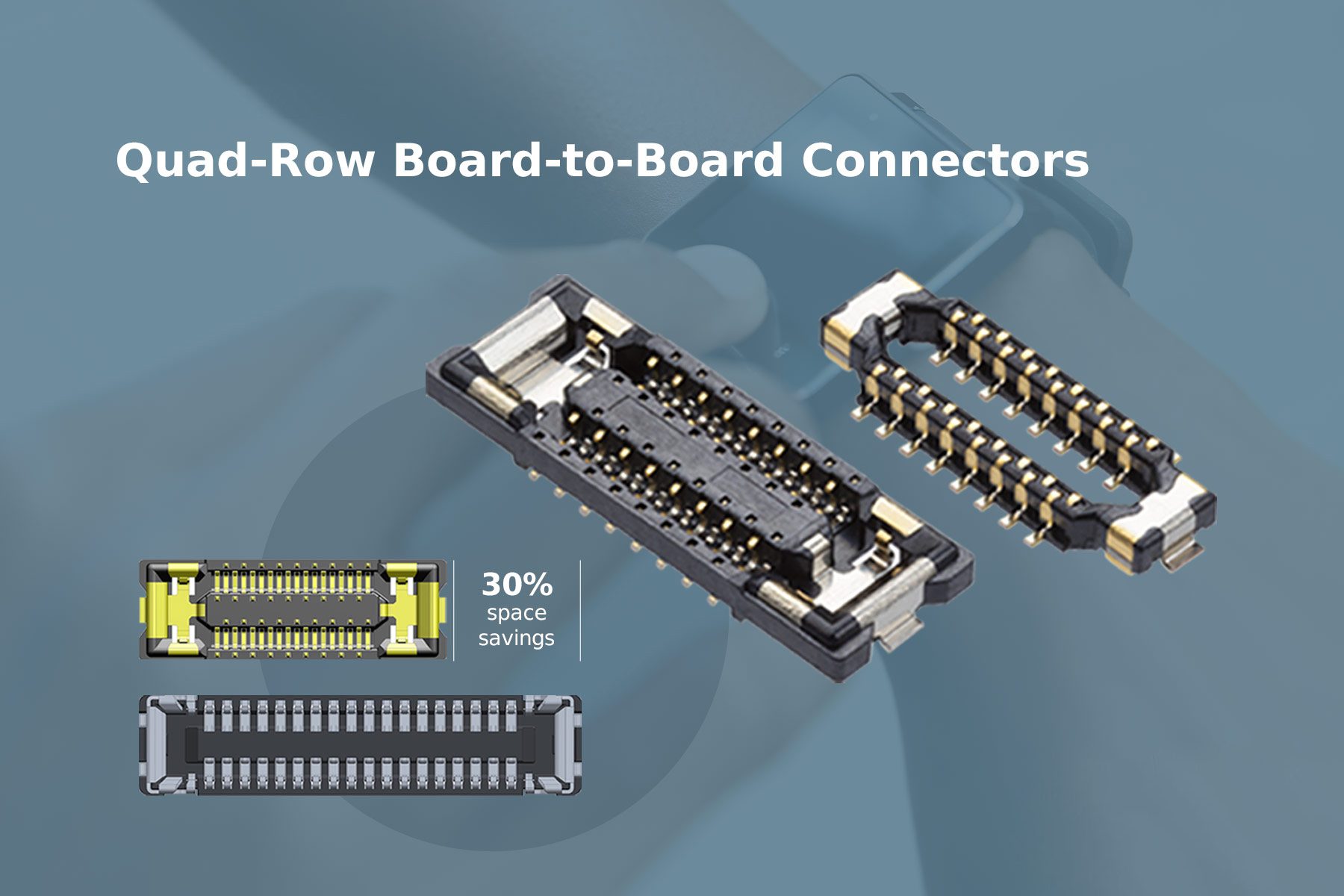Pitch Perfect: Creating Ever-Smaller Connectors to Enable the Latest Consumer Devices
Connectors that once were market leaders now are too large for most consumer applications. The next level of refinement in design comes in the form of fine-pitch alternatives.

The world of consumer electronic devices has expanded enormously in the last decade. With applications in the leisure market as well as personal healthcare and industry, handheld and wearable devices will dominate the consumer market. At the same time, these devices are offering more advanced features, requiring the latest in processor power, battery technology and high-speed connectivity. Alas, connectors that once were market leaders now are too large for most consumer applications. As a result, the industry is embracing the next level of refinement in design: fine-pitch alternatives.
Pitch is defined as the distance between the center of one contact and its nearest neighbor. For decades, pitch has served as a shorthand for how much space a connector will take up on the printed circuit board (PCB). When the first electronics were introduced in homes, size was not the first concern. Power supplies, microprocessors, and displays were all huge by today’s standards, and connector manufacturers were under little pressure to create smaller solutions. But clearly, times have changed.
Fine Pitch and Surface Mount
As the consumer electronics industry matured, the overall size of devices began to shrink as the technology – particularly microprocessors – became more compact. And suddenly, connectors with a large pitch became a limiting factor in achieving smaller PCBs. This was made even more critical when surface-mount technology became common. Unlike through-hole termination, which requires a circular hole to be drilled through the PCB, surface-mount devices require pads to be printed on a board that can be only as large as the terminals that are anchored to them.
Connectors have been forced to shrink, and the current generation of board-to-board connectors offers a pitch of 0.5mm or less. Despite this, the trend for smaller connectors continues with virtual reality glasses, smart watches, and other wearable devices being introduced in streamlined form factors. With such low-profile applications becoming common, the question facing both connector manufacturers and designers is, “how small is too small?”
This is a critical question because there are challenges associated with fine-pitch connectors. The first is mechanical strength. For a connector with a pitch of 0.5 mm, the contacts need to be smaller still to allow sufficient space between one contact and the next. These are usually manufactured using a stamping process, which forms the contact from a flat sheet of metal. Contacts with a thickness of less than 0.5 mm are delicate and require special handling.
A connector also requires an insulator body that will maintain the separation between each contact and provide the protection to prevent damage during use. These insulators are moulded from a range of plastic materials that need to be very thin to be used in fine-pitch connectors. With both contacts and the connector housing manufactured from such thin materials, the latest board-to-board connectors risk being too fragile for everyday use.
Therefore, the designer must consider how the connectors will be employed. If a connector offers a pitch of 0.5 mm, then the traces on the PCB must be similarly compact. This means the PCB layout needs to be designed with considerable care.
Preparing the PCB for Finer Pitch Connectors
When populating the PCB with components, the connector must be placed with a high level of accuracy. If the contact pitch is just 0.5 mm, then tolerances for placement are significantly lower. Accurate placement is also important if the connectors provide the link between two parallel boards.
The incredibly fine pitch of the PCB traces and contacts also have implications for the electrical signals they carry. Parallel traces located close together introduce the danger of crosstalk – the interference of one signal trace caused by another. Small size and proximity also limit the amount of power that can be transmitted through such fine contacts.
Therefore, in the race to create ever-smaller connectors for the latest consumer technology, it cannot be assumed that connector pitch can continue down this path to ever-smaller sizes. Simply making connectors smaller with finer pitch will become uneconomical. Many consumer devices are made in quantities of millions, so the connectors that service them must be available in mass quantities through mass production. Creating an alternative connector required designers to challenge their assumptions.
Challenging Assumptions
The first assumption that can be abandoned is conventional contact design. For many years, the length and height of a printed circuit board connector was governed by the design of the contacts. Conventional contacts depend on a long pin that enters a receptacle to make reliable electrical contact. Many attempts were made to keep this height to a minimum, but the plug-and-receptacle design prevents the height from being reduced to less than the length of the pin.
The latest trend in contact design for board-to-board connectors, however, employs wiping contacts. This arrangement is not only simpler to manufacture, but also reduces the overall connector size, allowing for a much smaller board-to-board stacking height. This, in conjunction with the shrinking size of other PCB-mounted components, enables consumer devices to be made smaller.
Other assumptions need to be challenged. Many board-to-board connectors have traditionally used two rows of contacts. This is a more robust solution than a single row, but there is a simple relationship between the number of contacts and length of the connector. A higher circuit count makes a larger connector.
The Quad-Row Solution
Molex has adopted a novel approach with its Quad-Row connector system. Instead of using two rows of contacts in a conventional arrangement, Quad-Row uses two pairs of contact rows that are staggered. By staggering the contacts on either side of the insulator, the mating pitch can be reduced to 0.175 mm, while the pitch between the PCB mounting terminals can be maintained at a more practical 3.5 mm.

Quad-Row Board-to-Board Connectors from Molex features a staggered circuit layout, which positions pins across four rows at a signal contact pitch of 0.175mm to deliver space savings while enabling high-density circuit connectivity.
The dual-beam design of the Quad-Row connector offers the contact density of a much smaller connector, while still maintaining a more practical PCB layout. The connector also enjoys superior mechanical strength provided by the power terminals at each end. These power terminals deliver not only a secure fixing site to allow better connector retention on the PCB, they also serve as a grounding path or even a way to transfer power from one board to another.
The design of the power terminals also prevents damage in use. They are designed to be used even if slightly misaligned, making the joining of two PCBs with such small connectors easier when conducted by hand.
As manufacturers continue to expand the functionality of small products like smartphones, earbuds, and AR/VR devices, their increasingly densely packed PCBs must remain height-scalable and maintain a small footprint. New connector designs like the Quad-Row can fuel sustained innovation without issues regarding signal integrity.
Connectors for the latest consumer electronics require a unique combination of small size, fine pitch, robust design, and high performance. To meet the growing consumer demand, manufacturers can no longer depend on established techniques and familiar solutions. Molex’s Quad-Row connector is a forward-thinking example of how designers can create new and innovative ways to solve familiar problems.
To learn more about miniaturized connectivity solutions for 3C, visit Molex.
Like this article? Check out our other articles on high density connectors, board-to-board connectors, our Consumer Market Page, and our 2022 Article Archive.
Subscribe to our weekly e-newsletters, follow us on LinkedIn, Twitter, and Facebook, and check out our eBook archives for more applicable, expert-informed connectivity content.





